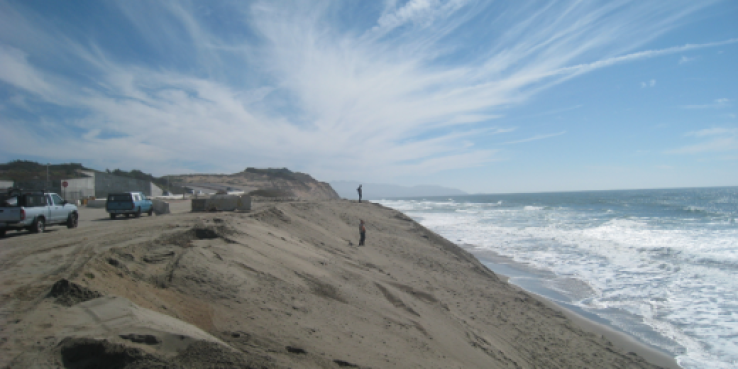The City of San Francisco and the National Parks Service recently partnered to fight erosion by placing sand at the southern end of Ocean Beach. Image courtesy of the San Francisco Department of Public Works.
Over the past two months, the National Park Service, Public Utilities Commission and Department of Public Works collaborated to move more than 73,300 cubic yards of sand from the north to the south end of Ocean Beach to provide protection against erosion. This process stabilizes the coast temporarily and provides useful data about coastal erosion rates. In addition to reducing the need for more engineered erosion protection measures, such as large piles of boulders, the Ocean Beach Sand Management Project also restores public access on the north end of the beach, where sand had built up, blocking the promenade and stairwells.
Why does sand erode in some places and accrete in others? Sand accumulates at the northern end of the beach through a complex interplay of natural sediment dynamics and management practices. Among other things, United States Army Corps of Engineers annually dredges the Golden Gate Marine Shipping Channel through an offshore sandbar and places the dredged sand in two sites, where it is picked up by ocean currents and eventually deposited on Ocean Beach. The effects are especially notable during the spring, when shifting winds and currents deposit significant amounts of sand and create large sand mounds in the north. This system is part of a pattern of sediment circulation that moves sand from the Golden Gate to about the middle of Ocean Beach, gradually pushing it northward. (See a video of this process in action.)
While the northern end of Ocean Beach has been widening due to these natural and manmade factors, the southern end of Ocean Beach experiences a net loss of sediment as circulation patterns move sand southward. Winter storms will probably cause additional erosion near Sloat Boulevard. Unchecked, this erosion is likely to have environmental consequences and damage city infrastructure, including San Francisco’s wastewater treatment system.
Going forward, the Army Corps of Engineers plans to eliminate the need to move sand by truck and will deposit dredged sand directly where erosion is worst. The Corps will move four times this year’s volume of sand from the Marine Shipping Channel and pump it directly onto the beach near the intersection of Great Highway and Sloat Boulevard. This beach nourishment project is fundamental to recommendations SPUR has made in the Ocean Beach Master Plan. It is also part of the Coastal Regional Sediment Management Plan, a new interagency effort between the Army Corps and the California Natural Resources Agency. That process will study sediment management options from Baker Beach in San Francisco to Shelter Cove in Pacifica, including beach nourishment, artificial reefs and managed retreat.
As SPUR and our partners continue to plan for climate change and sea level rise at Ocean Beach, these kinds of nimble, adaptive multi-agency efforts will become increasingly important. Projects like these help bridge the gap until SPUR’s Ocean Beach Master Plan recommendations can be implemented.
